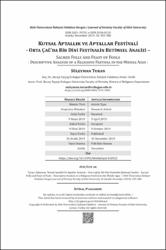| dc.contributor.author | Turan, Süleyman | |
| dc.date.accessioned | 2020-12-19T19:40:41Z | |
| dc.date.available | 2020-12-19T19:40:41Z | |
| dc.date.issued | 2019 | |
| dc.identifier.citation | Turan, S. (2019). Kutsal aptallık ve aptallar festivali - Orta Çağ’da bir dini festivalin betimsel analizi –. Hitit Universitesi Ilahiyat Fakultesi Dergisi, 18(36), 557-581. https://doi.org/10.14395/hititilahiyat.542022 | en_US |
| dc.identifier.issn | 2651-3978 | |
| dc.identifier.issn | 2636-8110 | |
| dc.identifier.uri | https://doi.org/10.14395/hititilahiyat.542022 | |
| dc.identifier.uri | https://hdl.handle.net/11436/1622 | |
| dc.description | WOS: 000509351100009 | en_US |
| dc.description.abstract | This article is about a religious festival entitled "The Feast of Fools". the Feast of Fools was a festival celebrated annually on 1 January for the day of the Circumcision in many parts of Europe, and especially in France. It approximately continued from the end of the eleventh to the end of the sixteenth century. Roots of this festival can be traced to ancient Roman festival, Saturnalia. It is claimed that during this festival priests and clerks wore animal and wild beast masks and women's clothings, ate black puddings while the celebrant was saying mass, thrown dice at the altar, drank excessively, run and jump through the church, sang obscene and bawdy hymnal songs, and they defaced the words and songs of the liturgy. the feast is shortly characterized by its reversals. As far as we can see, in its excessive form it was never affirmed by Church authorities; on the contrary, it was restricted and regularly forbidden. Eventually it was abrogated in the 16th century. But its traces have been continuing until now and some festivals such Mardi Gras carries and reflects the traces of this festival. | en_US |
| dc.language.iso | tur | en_US |
| dc.publisher | Hitit Univ | en_US |
| dc.rights | info:eu-repo/semantics/openAccess | en_US |
| dc.subject | History of religions | en_US |
| dc.subject | Feast of fools | en_US |
| dc.subject | Christianity | en_US |
| dc.subject | Middle Ages | en_US |
| dc.subject | France | en_US |
| dc.subject | Mardi Gras | en_US |
| dc.title | Kutsal aptallık ve aptallar festivali - Orta Çağ’da bir dini festivalin betimsel analizi – | en_US |
| dc.title.alternative | Sacred folly and feast of fools - Descriptıve analysıs of a religious festival in the Middle Ages - | en_US |
| dc.type | article | en_US |
| dc.contributor.department | RTEÜ, İlahiyat Fakültesi, Felsefe ve Din Bilimleri Bölümü | en_US |
| dc.contributor.institutionauthor | Turan, Süleyman | |
| dc.identifier.doi | 10.14395/hititilahiyat.542022 | |
| dc.identifier.volume | 18 | en_US |
| dc.identifier.issue | 36 | en_US |
| dc.identifier.startpage | 557 | en_US |
| dc.identifier.endpage | 581 | en_US |
| dc.ri.edit | oa | en_US |
| dc.relation.journal | Hitit Universitesi Ilahiyat Fakultesi Dergisi-Journal of Divinity Faculty of Hitit University | en_US |
| dc.relation.publicationcategory | Makale - Uluslararası Hakemli Dergi - Kurum Öğretim Elemanı | en_US |


















